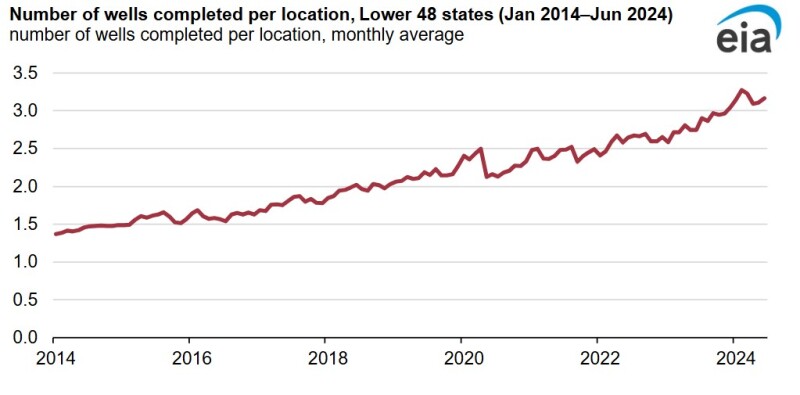A new report from the US Energy Information Administration (EIA) found that the average number of horizontal wells completed at the same time has more than doubled over the past decade—from 1.5 in 2014 to just over 3 in 2024.
The trend reflects a continual evolution in US onshore hydraulic fracturing operations. What began as two-well “simulfracs” has grown into three-well “trimulfracs,” with some operators now embracing four-well “quadfracs.”
“The increasing number of simultaneous completions reflects significant technological advances in hydraulic fracturing operations, particularly in equipment capabilities and operational strategies,” the EIA said.
Chevron shared at the SPE Permian Basin Energy Conference in November that it had recently adopted trimulfracs in the basin. The US supermajor later told Reuters it plans to use the three-well completion method on up to 60% of new wells this year, up from 20% last year.
Independent producer Matador Resources also reported success with remote trimulfrac operations last year, noting a 25% reduction in completion time and $1.1 million in savings compared with less efficient simulfrac or zipper fracturing methods.
“Our analysis of FracFocus data suggests that simultaneous completions have increased since 2017, with operators now routinely completing multiple wells at a time on a single location,” the EIA report said. “Although operators recognized the potential benefits … prior to 2017, the practice initially faced technical barriers, such as the need for more hydraulic horsepower.”

The report also found that while the number of active pad sites has declined since 2014, the number of wells completed has risen, a result the EIA links to the growing use of simultaneous completions.
Electric fracturing fleets are among the technologies the EIA identified as “crucial” to the rise of simultaneous completions, noting that they offer better power management than traditional diesel-powered pumps. The research arm of the US Department of Energy said the electric fleets also help cut costs and ease logistical challenges by using locally sourced sources of power, namely natural gas and grid electricity, if available.
“Additionally, improvements in equipment monitoring, optimization, and automation have helped operators manage the complexity of simultaneous completions,” the report said.
The EIA added that although not all shale operators have adopted simulfracs or trimulfracs, the technology needed to execute them is now widely accessible across the major US shale plays.


